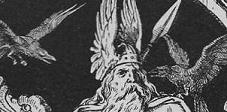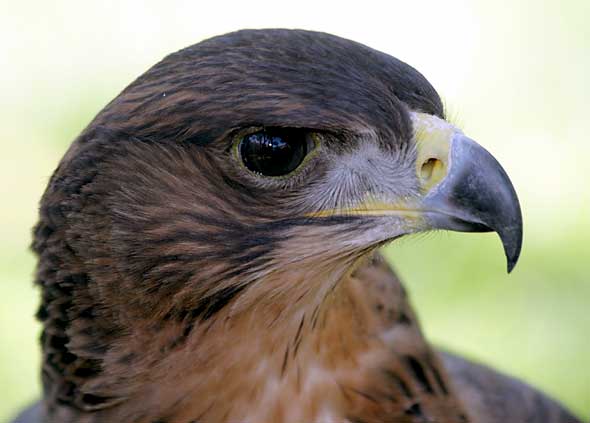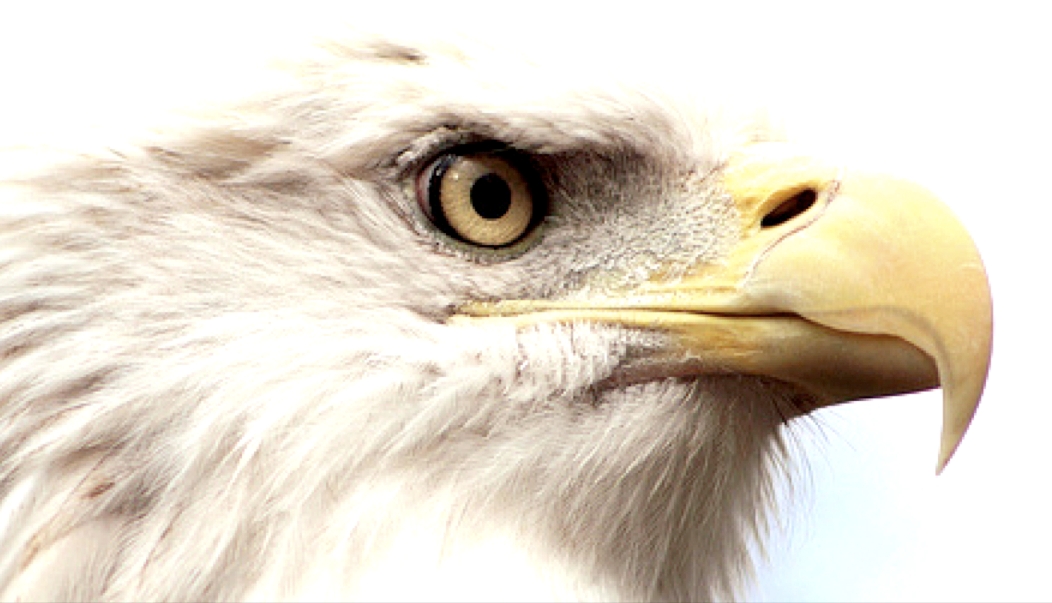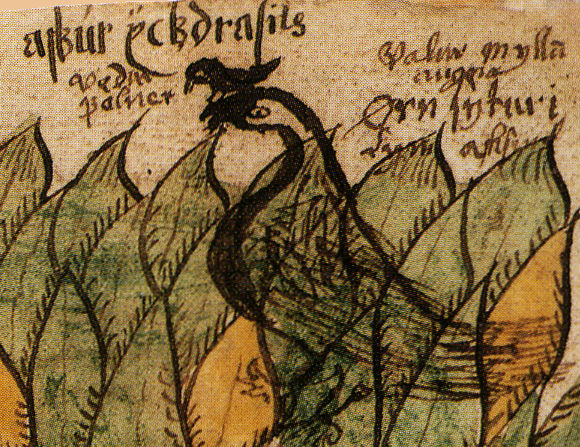The Poetic Edda: A Study Guide
The Speech of the Masked One

[PREVIOUS][MAIN][NEXT]
[HOME]
And between his eyes sits a hawk."
 |
||
 |
Scholars have long proposed a lost verse of Grímnismál said to occur between stanzas 31 and 32. This is clearly based on a close reading of Snorri's Edda.
In Gylfaginning 16, Snorri writes:
| Þá mælti Gangleri: "Hvat er fleira at segja stórmerkja frá askinum?"
Hárr segir: "Margt er þar af at segja. Örn einn sitr í limum asksins, ok er hann margs vitandi, en í milli augna honum sitr haukr, sá er heitir Veðrfölnir. Íkorni sá, er heitir Ratatoskr, renn upp ok niðr eftir askinum ok berr öfundarorð milli arnarins ok Níðhöggs, en fjórir hirtir renna í limum asksins ok bíta barr. Þeir heita svá: Dáinn, Dvalinn, Duneyrr, Duraþrór. En svá margir ormar eru í Hvergelmi með Níðhögg, at engi tunga má telja. Svá segir hér: |
Then said Gangleri: "What more mighty wonders are to be told of the Ash?" Hárr replied: "Much is to be told of it. An eagle sits in the limbs of the Ash, and he has understanding of many a thing; and between his eyes sits the hawk that is called Vedrfölnir. The squirrel called Ratatöskr runs up and down the length of the Ash, bearing envious words between the eagle and Nídhöggr; and four harts run in the limbs of the Ash and bite the leaves. They are called thus: Dáinn, Dvalinn, Duneyrr, Durathrór. Moreover, so many serpents are in Hvergelmir with Nídhöggr, that no tongue can tell them, as is here said: |
|
Askr Yggdrasils drýgir
erfiði |
Ash Yggdrasill |
suffers anguish, More than men know of: The stag bites above; | on the side it rotteth, And Nídhöggr gnaws from below. |
The information about the four harts is contained in Grímnismál 33. Thus, some scholars have reasoned that the information about the eagle and the hawk must have come from a lost verse of this poem. Nevermind that we have the poem in two manuscripts, and there is no indication of a lacuna whatsoever. Moreover, the supposedly lost verse does not appear in later paper manuscripts of the poem.
It is
demonstrably a scholarly creation based on a close reading of Gylfaginning 16, and attributing
Snorri's text with undue weight.
This just goes to show how strong an influence Snorri’s Edda was in
interpreting the poems of the Poetic Edda was more than a century into
modern Eddic studies.
The lost verse, once proposed as a theory, was accepted into subsequent English translations and commentaries, and
held for
almost 80 years. Since the 1960s, scholars no longer mention it.
Of this verse, Gudbrand Vigfusson, in his Corpus Poeticum Boreale (1883) writes:
“24-29. Three roots stretch three ways under the
ash Ygg's-steed. Hell dwells under one, the Frost Giants under the
second, mortal men under the third.”
“…Here one verse is dropped, of which Edda (Snorri) gives a paraphrase.”
Vigfusson provides a translation of the verse he refers to here as:
“An eagle sits in the branches of the ash
Ygg's-steed, called . . . . , and between his eyes sits a hawk, that is
called Weather- pale.”
In his Kommentar, p. 201, R.C. Boer supplied
another version of the missing verse. He writes:
Nach 31 fehlt eine strophe. Das ergibt sich
daraus, dass von dem 32 erwähnten örn schon vorher etwas gesagt sein
musste und dass Snorri für seine prosa (Sn.E I, 74) offenbar eine
poetische quelle benutzte [s. den text band z. st.]. Hieraus denselben
selbstverständlichen schluss zu ziehen, wie Mogk, Müllenhoff und
Gudbrandr Vigfusson, haben Detter-Heinzel und Neckel nicht gewagt [s.
auch Boer II, 66] Die strophe lässt sich sogar aus Snorres umschreibung
mit annähernder sicherheit wiederherstellen:
"After 31 a strophe is missing. The results from the fact that of the 32
previously mentioned örn (eagle) something had to be said for his prose and that
Snorri (Sn.E, 74) apparently used a poetic source [see the text volume
for st.]. From drawing this same obvious conclusion as Mogk, Müllenhoff
Gudbrandr and Vigfusson, and have not dared to see Detter-Heinzel and
Neckel [Boer also II, 66] The strophe can even be recovered from Snorri
paraphrase with a degree of safety:"
Örn sitr á asks limom
Es vel kveþa mart vita;
Ögler einn hönom augna í mille
Veþrfölner vaker.
Diese herstellung, die Gering in den text seiner.
"This creation, Gering provides in his text."
In 1908, Olive Bray inserted a different version of this verse into her
translation of Grimnismál:
“An eagle sits in the boughs of the ash,
knowing much of many things;
and a hawk is perched, Storm-pale, aloft
betwixt that eagle’s eyes.”
She remarks:
“Not found in the MSS, but reconstructed from the
prose of Sn.E (by Gering).”
And of this theory, in 1923, Henry Bellows in his translation of The
Poetic Edda writes:
“After this stanza it is more than possible that
one has been lost, paraphrased in Snorri’s Edda thus: “An eagle sits in
the branches of the ash-tree, and he is very wise; and between his eyes
sits the hawk who is called Vethrfolnir.”
Then, remarkably, in 1962, Lee Hollander in his translation of The Poetic Edda issued the final words on the subject:
32. (An
eagle sitteth on Yggdrasil's limbs,
whose keen eyes widely ken;
'twixt his eyes a fallow falcon is perched,
hight Vethrfolnir, and watcheth.)
"This stanza is lacking in the original. We are able to reconstruct it
from Snorri's close paraphrase ("Gylfaginning," Chap. 15). The eagle and
the falcon possibly symbolize the watchfulness of the gods."
After this, the issue quietly faded away.

from an illustrated copy of The Prose Edda, 1760
[PREVIOUS][MAIN][NEXT]
[HOME]